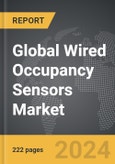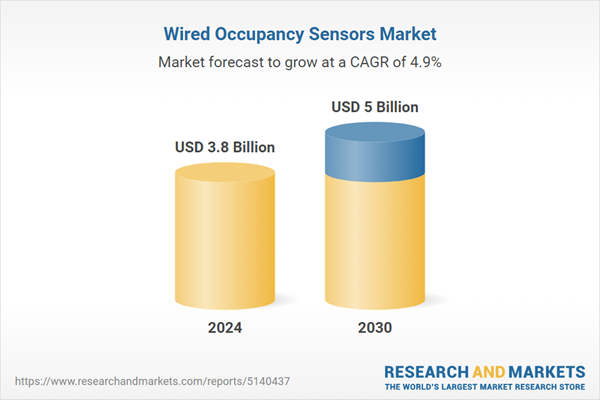The global market for Wired Occupancy Sensors was valued at US$3.8 Billion in 2024 and is projected to reach US$5.0 Billion by 2030, growing at a CAGR of 4.9% from 2024 to 2030. This comprehensive report provides an in-depth analysis of market trends, drivers, and forecasts, helping you make informed business decisions. The report includes the most recent global tariff developments and how they impact the Wired Occupancy Sensors market.
Segments: End-Use (Hotels, Residential, Corporate Offices, Other End-Uses).
Geographic Regions/Countries: World; United States; Canada; Japan; China; Europe (France; Germany; Italy; United Kingdom; Spain; Russia; and Rest of Europe); Asia-Pacific (Australia; India; South Korea; and Rest of Asia-Pacific); Latin America (Argentina; Brazil; Mexico; and Rest of Latin America); Middle East (Iran; Israel; Saudi Arabia; United Arab Emirates; and Rest of Middle East); and Africa.
The analysts continuously track trade developments worldwide, drawing insights from leading global economists and over 200 industry and policy institutions, including think tanks, trade organizations, and national economic advisory bodies. This intelligence is integrated into forecasting models to provide timely, data-driven analysis of emerging risks and opportunities.
Global Wired Occupancy Sensors Market - Key Trends & Drivers Summarized
Why Are Wired Occupancy Sensors Becoming Essential in Modern Buildings?
Wired occupancy sensors are becoming increasingly important in modern building automation systems due to their ability to enhance energy efficiency, optimize lighting, and improve security. These sensors detect the presence or absence of occupants in a room or area and automatically adjust lighting, HVAC, and security systems accordingly. The growing emphasis on reducing energy consumption and operational costs in residential, commercial, and industrial buildings is driving the demand for wired occupancy sensors that offer reliable and precise detection capabilities. With the rise of smart buildings and green building initiatives, wired occupancy sensors are becoming an integral part of intelligent building management systems that aim to provide a comfortable, safe, and energy-efficient environment.How Are Technological Advancements Enhancing Wired Occupancy Sensors?
Technological advancements in sensor design, data analytics, and integration capabilities are significantly enhancing the performance and versatility of wired occupancy sensors. Innovations such as dual-technology sensors that combine passive infrared (PIR) and ultrasonic sensing are providing more accurate and reliable detection in various environments. The development of microprocessor-based sensors with built-in intelligence is enabling real-time data processing and adaptive learning, allowing sensors to adjust their sensitivity and response based on occupancy patterns. Additionally, the integration of wired occupancy sensors with advanced building management systems (BMS) and IoT platforms is enabling centralized control, remote monitoring, and predictive maintenance, enhancing overall building efficiency and occupant comfort.What Are the Challenges and Opportunities in the Wired Occupancy Sensors Market?
The wired occupancy sensors market faces several challenges, including high installation costs, compatibility issues with existing building infrastructure, and the need for regular maintenance and calibration. Additionally, the increasing adoption of wireless occupancy sensors and smart lighting solutions may pose a competitive challenge to traditional wired sensors. However, these challenges also present opportunities for growth and differentiation. The development of cost-effective, easy-to-install wired occupancy sensors that offer seamless integration with various building systems is gaining popularity. The growing demand for sensors with advanced features such as daylight harvesting, HVAC control, and data analytics is creating new growth opportunities for wired sensor manufacturers. Moreover, the increasing focus on energy efficiency, sustainability, and occupant comfort in smart buildings is driving the need for reliable and high-performance wired occupancy sensors.What Is Driving the Growth of the Wired Occupancy Sensors Market?
The growth in the Wired Occupancy Sensors market is driven by several factors, including the increasing adoption of energy-efficient building automation systems, rising demand for intelligent lighting and HVAC controls, and technological advancements in sensor design and integration. The need for precise and reliable occupancy detection to optimize energy use, enhance security, and improve occupant comfort is significantly boosting market demand for wired occupancy sensors in residential, commercial, and industrial applications. Technological innovations such as dual-technology sensors, microprocessor-based intelligence, and IoT-enabled integration are enhancing the capabilities and appeal of wired occupancy sensors, making them more attractive to building owners, facility managers, and smart building developers. The expansion of smart city projects, green building certifications, and energy management initiatives, coupled with the growing emphasis on sustainability and operational efficiency, is also driving market growth as stakeholders seek advanced and integrated occupancy sensing solutions.Report Scope
The report analyzes the Wired Occupancy Sensors market, presented in terms of units. The analysis covers the key segments and geographic regions outlined below.Segments: End-Use (Hotels, Residential, Corporate Offices, Other End-Uses).
Geographic Regions/Countries: World; United States; Canada; Japan; China; Europe (France; Germany; Italy; United Kingdom; Spain; Russia; and Rest of Europe); Asia-Pacific (Australia; India; South Korea; and Rest of Asia-Pacific); Latin America (Argentina; Brazil; Mexico; and Rest of Latin America); Middle East (Iran; Israel; Saudi Arabia; United Arab Emirates; and Rest of Middle East); and Africa.
Key Insights:
- Market Growth: Understand the significant growth trajectory of the Hotels segment, which is expected to reach US$2.2 Billion by 2030 with a CAGR of a 5.1%. The Residential segment is also set to grow at 5.4% CAGR over the analysis period.
- Regional Analysis: Gain insights into the U.S. market, valued at $987.9 Million in 2024, and China, forecasted to grow at an impressive 8.4% CAGR to reach $1.2 Billion by 2030. Discover growth trends in other key regions, including Japan, Canada, Germany, and the Asia-Pacific.
Why You Should Buy This Report:
- Detailed Market Analysis: Access a thorough analysis of the Global Wired Occupancy Sensors Market, covering all major geographic regions and market segments.
- Competitive Insights: Get an overview of the competitive landscape, including the market presence of major players across different geographies.
- Future Trends and Drivers: Understand the key trends and drivers shaping the future of the Global Wired Occupancy Sensors Market.
- Actionable Insights: Benefit from actionable insights that can help you identify new revenue opportunities and make strategic business decisions.
Key Questions Answered:
- How is the Global Wired Occupancy Sensors Market expected to evolve by 2030?
- What are the main drivers and restraints affecting the market?
- Which market segments will grow the most over the forecast period?
- How will market shares for different regions and segments change by 2030?
- Who are the leading players in the market, and what are their prospects?
Report Features:
- Comprehensive Market Data: Independent analysis of annual sales and market forecasts in US$ Million from 2024 to 2030.
- In-Depth Regional Analysis: Detailed insights into key markets, including the U.S., China, Japan, Canada, Europe, Asia-Pacific, Latin America, Middle East, and Africa.
- Company Profiles: Coverage of players such as Dongguan Togran Electronics Technology Co., Ltd. (Togran), Eaton Corporation Plc, Honeywell International, Inc., Johnson Controls, Inc., Koninklijke Philips NV and more.
- Complimentary Updates: Receive free report updates for one year to keep you informed of the latest market developments.
Some of the 36 companies featured in this Wired Occupancy Sensors market report include:
- Dongguan Togran Electronics Technology Co., Ltd. (Togran)
- Eaton Corporation Plc
- Honeywell International, Inc.
- Johnson Controls, Inc.
- Koninklijke Philips NV
- Legrand North America, LLC.
- Leviton Manufacturing Co., Inc.
- Lutron Electronics Co., Inc.
- Schneider Electric
- Texas Instruments, Inc.
Tariff Impact Analysis: Key Insights for 2025
Global tariff negotiations across 180+ countries are reshaping supply chains, costs, and competitiveness. This report reflects the latest developments as of April 2025 and incorporates forward-looking insights into the market outlook.The analysts continuously track trade developments worldwide, drawing insights from leading global economists and over 200 industry and policy institutions, including think tanks, trade organizations, and national economic advisory bodies. This intelligence is integrated into forecasting models to provide timely, data-driven analysis of emerging risks and opportunities.
What’s Included in This Edition:
- Tariff-adjusted market forecasts by region and segment
- Analysis of cost and supply chain implications by sourcing and trade exposure
- Strategic insights into geographic shifts
Buyers receive a free July 2025 update with:
- Finalized tariff impacts and new trade agreement effects
- Updated projections reflecting global sourcing and cost shifts
- Expanded country-specific coverage across the industry
Table of Contents
I. METHODOLOGYII. EXECUTIVE SUMMARY2. FOCUS ON SELECT PLAYERSIII. MARKET ANALYSISIV. COMPETITION
1. MARKET OVERVIEW
3. MARKET TRENDS & DRIVERS
4. GLOBAL MARKET PERSPECTIVE
UNITED STATES
CANADA
JAPAN
CHINA
EUROPE
FRANCE
GERMANY
ITALY
UNITED KINGDOM
SPAIN
RUSSIA
REST OF EUROPE
ASIA-PACIFIC
AUSTRALIA
INDIA
SOUTH KOREA
REST OF ASIA-PACIFIC
LATIN AMERICA
ARGENTINA
BRAZIL
MEXICO
REST OF LATIN AMERICA
MIDDLE EAST
IRAN
ISRAEL
SAUDI ARABIA
UNITED ARAB EMIRATES
REST OF MIDDLE EAST
AFRICA
Companies Mentioned (Partial List)
A selection of companies mentioned in this report includes, but is not limited to:
- Dongguan Togran Electronics Technology Co., Ltd. (Togran)
- Eaton Corporation Plc
- Honeywell International, Inc.
- Johnson Controls, Inc.
- Koninklijke Philips NV
- Legrand North America, LLC.
- Leviton Manufacturing Co., Inc.
- Lutron Electronics Co., Inc.
- Schneider Electric
- Texas Instruments, Inc.
Table Information
| Report Attribute | Details |
|---|---|
| No. of Pages | 222 |
| Published | April 2025 |
| Forecast Period | 2024 - 2030 |
| Estimated Market Value ( USD | $ 3.8 Billion |
| Forecasted Market Value ( USD | $ 5 Billion |
| Compound Annual Growth Rate | 4.9% |
| Regions Covered | Global |









